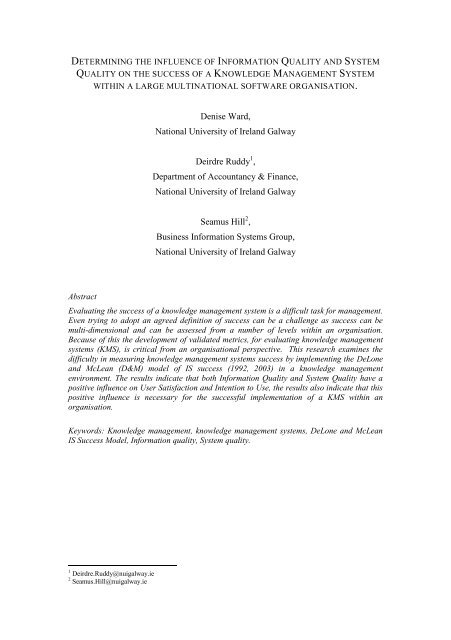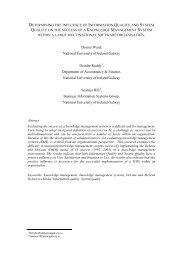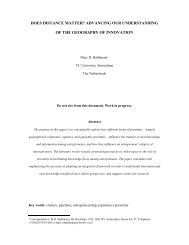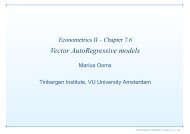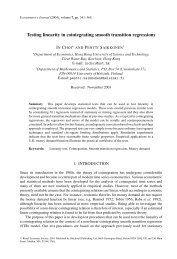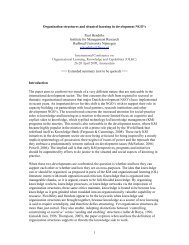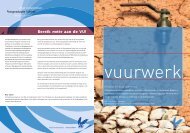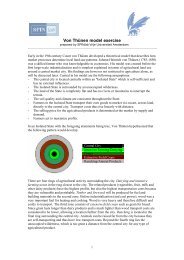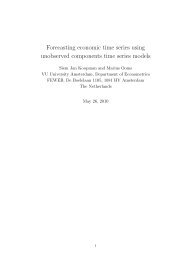Seamus Hill Determining the influence of Information Quality and ...
Seamus Hill Determining the influence of Information Quality and ...
Seamus Hill Determining the influence of Information Quality and ...
Create successful ePaper yourself
Turn your PDF publications into a flip-book with our unique Google optimized e-Paper software.
DETERMINING THE INFLUENCE OF INFORMATION QUALITY AND SYSTEM<br />
QUALITY ON THE SUCCESS OF A KNOWLEDGE MANAGEMENT SYSTEM<br />
WITHIN A LARGE MULTINATIONAL SOFTWARE ORGANISATION.<br />
Abstract<br />
Denise Ward,<br />
National University <strong>of</strong> Irel<strong>and</strong> Galway<br />
Deirdre Ruddy 1 ,<br />
Department <strong>of</strong> Accountancy & Finance,<br />
National University <strong>of</strong> Irel<strong>and</strong> Galway<br />
<strong>Seamus</strong> <strong>Hill</strong> 2 ,<br />
Business <strong>Information</strong> Systems Group,<br />
National University <strong>of</strong> Irel<strong>and</strong> Galway<br />
Evaluating <strong>the</strong> success <strong>of</strong> a knowledge management system is a difficult task for management.<br />
Even trying to adopt an agreed definition <strong>of</strong> success can be a challenge as success can be<br />
multi-dimensional <strong>and</strong> can be assessed from a number <strong>of</strong> levels within an organisation.<br />
Because <strong>of</strong> this <strong>the</strong> development <strong>of</strong> validated metrics, for evaluating knowledge management<br />
systems (KMS), is critical from an organisational perspective. This research examines <strong>the</strong><br />
difficulty in measuring knowledge management systems success by implementing <strong>the</strong> DeLone<br />
<strong>and</strong> McLean (D&M) model <strong>of</strong> IS success (1992, 2003) in a knowledge management<br />
environment. The results indicate that both <strong>Information</strong> <strong>Quality</strong> <strong>and</strong> System <strong>Quality</strong> have a<br />
positive <strong>influence</strong> on User Satisfaction <strong>and</strong> Intention to Use, <strong>the</strong> results also indicate that this<br />
positive <strong>influence</strong> is necessary for <strong>the</strong> successful implementation <strong>of</strong> a KMS within an<br />
organisation.<br />
Keywords: Knowledge management, knowledge management systems, DeLone <strong>and</strong> McLean<br />
IS Success Model, <strong>Information</strong> quality, System quality.<br />
1 Deirdre.Ruddy@nuigalway.ie<br />
2 <strong>Seamus</strong>.<strong>Hill</strong>@nuigalway.ie
1 INTRODUCTION<br />
As Organisational Memory <strong>and</strong> Knowledge Management become a driving force for<br />
many organisations, managing <strong>the</strong>se resources becomes vital. The developments in<br />
new <strong>Information</strong> Technology have led <strong>the</strong> way for <strong>the</strong> creation <strong>of</strong> Knowledge<br />
Management Systems (KMS). With companies endeavouring to control <strong>the</strong>se new<br />
systems, success becomes crucial. It is important to identify <strong>the</strong> measurements <strong>of</strong><br />
success so that KMS succeed. The DeLone <strong>and</strong> McLean <strong>Information</strong> System (D&M)<br />
IS success model has been mostly used to identify <strong>the</strong> success <strong>of</strong> <strong>Information</strong> Systems<br />
but rarely Knowledge Management Systems within organisations. This study <strong>of</strong>fers<br />
fur<strong>the</strong>r evidence that this model can be used as a foundation in <strong>the</strong> search to identify<br />
<strong>the</strong> success <strong>of</strong> a KMS.<br />
The success <strong>of</strong> a Knowledge Management System relies heavily on <strong>the</strong> use <strong>of</strong> <strong>the</strong><br />
system (Poston, 2005) which Wu & Wang (2006) believe is attached to System<br />
<strong>Quality</strong>, <strong>Information</strong> <strong>Quality</strong>, User Satisfaction <strong>and</strong> Usage. Actual use is most<br />
applicable as a success measure when <strong>the</strong> use <strong>of</strong> a system is required (Jennex &<br />
Olfman, 2004). However, Lucas, Welke <strong>and</strong> Konsynski (cited in DeLone 1988, p.<br />
52) state that actual use should only be used as a measure <strong>of</strong> success when use is<br />
voluntary. This is consistent with what DeLone & McLean (2003) state, that use<br />
should be included when use is voluntary. Knowledge Management Systems by<br />
nature involve voluntary use which would suggest that success can be best measured<br />
in this way.<br />
An Organisational Impact is “<strong>the</strong> effect <strong>of</strong> information on organisational<br />
performance” (DeLone & McLean 1992). It was as early as 1988 when DeLone<br />
(1988) identified organisational performance as having an impact on <strong>Information</strong><br />
Systems. Fan & Fang (2006) cite organisational effectiveness, organisational<br />
productivity <strong>and</strong> organisational pr<strong>of</strong>itability as three factors that can affect <strong>the</strong> success<br />
<strong>of</strong> an <strong>Information</strong> System. Gray (2000) states academics <strong>and</strong> researchers have been<br />
continually researching organisational impacts but little evidence exists on how KMS<br />
<strong>influence</strong>s organisational performance. Markus & Keil (cited in Malhotra & Galletta<br />
2004, p. 91) believe it is users <strong>and</strong> managers that enhance organisational performance<br />
<strong>and</strong> not <strong>the</strong> system itself.<br />
Knowledge Management has emerged as an <strong>Information</strong> System that organisations<br />
are constantly exploring <strong>and</strong> adopting. Research on Knowledge Management has<br />
mainly focused on <strong>the</strong> area <strong>of</strong> knowledge transfer <strong>and</strong> in recent studies it has been<br />
recognised that more diverse research is needed from a system user perspective<br />
(Peachey, 2005). Hahn & Subramani (2000) identifies a KMS as an analogous tool,<br />
one that is only successful if <strong>the</strong> users succeed with <strong>the</strong> tool. Malhotra & Galletta’s<br />
(2004) study conforms to this idea by stating that no matter how good a system is;<br />
users will not use it unless it helps <strong>the</strong>m with <strong>the</strong>ir work.
DeLone <strong>and</strong> McLean (1992) identified six categories <strong>of</strong> <strong>Information</strong> System success<br />
<strong>and</strong> <strong>the</strong>y believe that several success measures fall into <strong>the</strong>se categories. This would<br />
imply that <strong>the</strong> success <strong>of</strong> any <strong>Information</strong> System can be measured using this model.<br />
Not only does it contain many success measures but it is also noted that <strong>the</strong> categories<br />
are “interrelated <strong>and</strong> interdependent” (DeLone & McLean, 1992), two categories can<br />
toge<strong>the</strong>r create a stronger <strong>influence</strong> on ano<strong>the</strong>r variable. DeLone <strong>and</strong> Mclean (1992)<br />
believe that scrutinising <strong>the</strong>se relationships will yield superior measures <strong>of</strong> success.<br />
Previous research conducted by Yang, Ting & Wei (2006) revealed that every little<br />
research in <strong>Information</strong> Technology was conducted from a system user perspective.<br />
With this in mind this paper focuses on studing <strong>the</strong> system from <strong>the</strong> system user’s<br />
perspective, with users <strong>of</strong> <strong>the</strong> system being asked to provide <strong>the</strong>ir views on <strong>the</strong> quality<br />
<strong>of</strong> <strong>the</strong> information <strong>and</strong> <strong>of</strong> <strong>the</strong> system. The purpose <strong>of</strong> this paper is to shed light on<br />
<strong>the</strong> factors <strong>of</strong> <strong>Information</strong> <strong>and</strong> System <strong>Quality</strong>, from <strong>the</strong> users perspective, influencing<br />
<strong>the</strong> success <strong>of</strong> a Knowledge Management System.<br />
The paper is laid out as follows; section 2 looks at <strong>the</strong> <strong>the</strong>oretical background, section<br />
3 outlines <strong>the</strong> research method chosen while section 4 presents <strong>the</strong> results. Section 5<br />
provides a discussion on <strong>the</strong> results <strong>and</strong> finally, section 6 concludes.<br />
2. THEORETICAL BACKGROUND<br />
2.1 Knowledge Management<br />
Knowledge has always been an important fundamental resource but it is only in <strong>the</strong><br />
last decade that companies have started to acknowledge <strong>the</strong> real benefits <strong>of</strong> managing<br />
it (Wiig, 1997; Ruggles, 1998; Hansen, Nohria & Tierney, 1999; Davies, 2000). The<br />
growth in <strong>Information</strong> Technology (IT) is one <strong>of</strong> <strong>the</strong> reasons for this shift<br />
(McDermott, 1999). Organisations are beginning to become more concerned about<br />
how knowledge is created by <strong>the</strong>ir employees <strong>and</strong> are continually considering ways to<br />
capture it. Humans have <strong>the</strong> capability to grasp <strong>and</strong> create <strong>the</strong> knowledge <strong>of</strong> <strong>the</strong><br />
organisation (Yeh, Lai & Ho, 2006) while <strong>Information</strong> Technology has <strong>the</strong> ability to<br />
<strong>influence</strong> it (McDermott, 1999). However, adopting <strong>the</strong> correct technology <strong>and</strong><br />
adjusting <strong>the</strong> culture may help in creating value within <strong>the</strong> organisation. Davenport,<br />
De Long & Beer (1998) cite that <strong>the</strong> difference between success <strong>and</strong> failure in an<br />
organisation can ultimately lie on whe<strong>the</strong>r <strong>the</strong> company can manage its knowledge.<br />
In <strong>the</strong> process <strong>of</strong> endeavouring to manage <strong>the</strong> knowledge <strong>of</strong> <strong>the</strong> organisation, a<br />
company must also consider <strong>the</strong> employees because without <strong>the</strong>m no new knowledge<br />
will be created. Massey, Montoya-Weiss & O’Driscoll (2002) reinforce this point by<br />
stating that human expertise coupled with exceptional technology can lead to<br />
outst<strong>and</strong>ing knowledge assets.<br />
A KMS is a specialised <strong>Information</strong> System (IS) with capabilities to systematise,<br />
facilitate, <strong>and</strong> expedite company-wide knowledge (Lee, 2005). KMS have fast
ecome a necessity <strong>of</strong> both large <strong>and</strong> small organisations <strong>and</strong> are viewed as a system<br />
that encompasses all knowledge related issues (Massey, Montoya-Weiss, &<br />
O'Driscoll, 2002). A KMS may be deemed successful when its use helps to achieve<br />
organisational goals, <strong>and</strong> can be viewed as inadequate if it is not used by <strong>the</strong> people it<br />
is intended for. H<strong>of</strong>fmann et al. (1999) identifies that knowledge owners <strong>and</strong> future<br />
users are important to <strong>the</strong> success <strong>of</strong> a KMS. The success <strong>of</strong> a KMS can indicate how<br />
well an organisation can manage its knowledge (Davenport, De Long & Beer, 1998).<br />
Davenport, De Long & Beer (1998) identify several factors that contribute to <strong>the</strong><br />
success <strong>of</strong> Knowledge Management projects but state that success is not solely<br />
restricted to <strong>the</strong>se. Money (2004) believes success should always begin with <strong>the</strong><br />
individual. If users don’t accept it, <strong>the</strong> system becomes a failure. Davenport, De<br />
Long & Beer (1998) <strong>and</strong> Massey, Montoya-Weiss & O’Driscoll (2002) identify<br />
people <strong>and</strong> resources as being at <strong>the</strong> core <strong>of</strong> any successful Knowledge Management<br />
project. Alavi & Leidner (2001) indicate that to increase <strong>the</strong> usage <strong>of</strong> a KMS, <strong>the</strong><br />
system must be designed in a way that users can find high quality material. Not only<br />
should it be <strong>of</strong> a high quality but <strong>the</strong> knowledge should also be easy to create, transfer<br />
<strong>and</strong> use (Davenport, De Long & Beer, 1998).<br />
2.2 DeLone & McLean <strong>Information</strong> Success Model<br />
As organisations continue to work in dynamic environments where change is constant<br />
(Gray, 2000) measuring <strong>the</strong> success <strong>of</strong> an <strong>Information</strong> System becomes critical.<br />
However, <strong>Information</strong> Systems success is still a construct that many researchers have<br />
never got to grips with (Molla & Licker, 2001). The DeLone <strong>and</strong> McLean<br />
<strong>Information</strong> Systems success model (DeLone & McLean, 1992) has been used by<br />
many researchers to measure <strong>the</strong> success <strong>of</strong> <strong>Information</strong> Systems. Despite many <strong>of</strong><br />
<strong>the</strong>se researchers (Seddon, 1997; Bradley, Pridmore & Byrd, 2006) altering <strong>and</strong><br />
adding variables to <strong>the</strong> D&M IS success model, very few studies exist on how this<br />
model can affect Knowledge Management Systems. Wu & Wang (2006), Jennex &<br />
Olfman (2004) <strong>and</strong> Kulkarni, Ravindran & Freeze (2006) extended <strong>the</strong> D&M IS<br />
success model to measure Knowledge Management System success. However, <strong>the</strong>re<br />
are two reasons why Wu & Wang (2006) believe that more studies need to be carried<br />
out, firstly to validate <strong>the</strong> D&M IS success model as an appropriate measure <strong>of</strong> KMS<br />
<strong>and</strong> secondly, most studies have focused on principles <strong>and</strong> case studies with very little<br />
on frameworks <strong>and</strong> models.<br />
The D&M IS success model was developed by DeLone <strong>and</strong> McLean (1992) to<br />
evaluate <strong>Information</strong> System success <strong>and</strong> provide a basis for future research. This<br />
model is based <strong>of</strong>f <strong>the</strong> work <strong>of</strong> Shannon & Weaver (1949) <strong>and</strong> Mason (1978)<br />
containing six measures <strong>of</strong> IS success. These variables are <strong>the</strong> result <strong>of</strong> merging a<br />
large number <strong>of</strong> studies on <strong>Information</strong> System success. The variables are interrelated<br />
ra<strong>the</strong>r than independent, see figure 1.
<strong>Information</strong><br />
<strong>Quality</strong><br />
System<br />
<strong>Quality</strong><br />
Figure 1: D&M IS Success Model (DeLone & McLean 1992)<br />
System <strong>Quality</strong> <strong>and</strong> <strong>Information</strong> <strong>Quality</strong> singularly <strong>and</strong> jointly affect both Intention to<br />
Use <strong>and</strong> User Satisfaction. Intention to Use <strong>and</strong> User Satisfaction can have an impact<br />
on one ano<strong>the</strong>r while <strong>the</strong>y both can have a direct affect on individual impacts which in<br />
turn affects organisational impacts (DeLone & McLean, 1992). Seddon (1997, p.<br />
242) concludes that <strong>the</strong> D&M IS success model can cause confusion when measuring<br />
<strong>Information</strong> Systems success as it contains “temporal <strong>and</strong> causal interdependencies”.<br />
He believes that <strong>the</strong> Use variable contains up to three meanings, (“benefits from use,<br />
impact <strong>of</strong> use <strong>and</strong> future IS use”) however, after analysing each meaning it is found<br />
that only one <strong>of</strong> <strong>the</strong>se (benefits from use) can be applied to <strong>the</strong> D&M IS success<br />
model. Although <strong>the</strong> 1992 model (DeLone & Mclean, 1992) is referred to as <strong>the</strong><br />
original model it is by no means a complete model. DeLone & McLean (2003) have<br />
since updated this model to include research conducted between 1992 <strong>and</strong> 2003, see<br />
figure 2 Revised D&M IS success model. The variables displayed in figure 3,<br />
Adapted D&M IS success model, represent <strong>the</strong> variables used in this study.<br />
<strong>Information</strong><br />
<strong>Quality</strong><br />
System<br />
<strong>Quality</strong><br />
Service<br />
<strong>Quality</strong><br />
Intention<br />
to Use<br />
User<br />
Satisfaction<br />
Use<br />
Intention to<br />
Use<br />
User<br />
Satisfaction<br />
Individual<br />
Impact<br />
Net<br />
Benefits<br />
Organisation<br />
Impact<br />
Figure 2: Revised D&M IS Success Model (DeLone & McLean 2003)
Figure 3: Adopted D&M IS Success Model (DeLone & McLean, 2003)<br />
2.3 Measures <strong>of</strong> <strong>Information</strong> System <strong>Quality</strong><br />
2.3.1 <strong>Information</strong> <strong>Quality</strong><br />
<strong>Information</strong> <strong>Quality</strong> is defined by DeLone & McLean (1992) as “<strong>the</strong> measure <strong>of</strong><br />
information system output”. It is also known as Knowledge <strong>Quality</strong> (Wu & Wang,<br />
2006) <strong>and</strong> referred to as measuring <strong>the</strong> information produced in a system (Jennex et<br />
al., 1998; Maes & Poels, 2006; Yang, Ting & Wei, 2006). Bradley, Pridmore & Byrd<br />
(2006) cite that information is <strong>the</strong> cornerstone <strong>of</strong> any organisation. There are many<br />
different measures <strong>of</strong> <strong>Information</strong> <strong>Quality</strong>, Bradley, Pridmore & Byrd (2006) state<br />
that it is important that information is timely, accurate, complete <strong>and</strong> thorough. Molla<br />
& Licker (2001) agree with Bradley, Pridmore & Byrd but also takes account <strong>of</strong> upto-datedness,<br />
underst<strong>and</strong>ability, reliability, relevancy, currency <strong>and</strong> preciseness.<br />
Jennex et al. (1998) identifies importance, relevance, usefulness <strong>and</strong> informativeness<br />
to clarity, content, accuracy <strong>and</strong> completeness as factors contributing to <strong>Information</strong><br />
<strong>Quality</strong> while Lee & Kozar (2006) cite relevance, currency <strong>and</strong> underst<strong>and</strong>ability.<br />
The most cited dimensions are accuracy, timeliness, completeness, relevancy <strong>and</strong><br />
reliability.<br />
2.3.2 System <strong>Quality</strong><br />
<strong>Information</strong><br />
<strong>Quality</strong><br />
System<br />
<strong>Quality</strong><br />
Intention to<br />
Use<br />
User<br />
Satisfaction<br />
System <strong>Quality</strong> is defined as “measures <strong>of</strong> <strong>the</strong> information processing system itself”<br />
(DeLone & McLean 1992). In a Knowledge Management context, Jennex (2005)<br />
defines System <strong>Quality</strong> as how well <strong>the</strong> KMS performs <strong>the</strong> functions <strong>of</strong> knowledge<br />
creation, storage/retrieval, transfer <strong>and</strong> application while Wu & Wang (2006) identify<br />
System <strong>Quality</strong> as how well <strong>the</strong> KMS performs in terms <strong>of</strong> its operational features.<br />
However, Doll & Torkzadeh (cited in Rai , Lang & Welker 2002, p 55) believe that<br />
System <strong>Quality</strong> has been used to measure both ease <strong>of</strong> use <strong>and</strong> <strong>the</strong> degree to which a<br />
system is user friendly. Nelson, Todd & Wixom (2005) believe that to-date, System<br />
<strong>Quality</strong> hasn’t received as much attention as <strong>Information</strong> <strong>Quality</strong>. A reason for this,<br />
maybe that System <strong>Quality</strong> can only be measured when a person uses or interacts with<br />
a system (Maes & Poels, 2006). The higher <strong>the</strong> quality <strong>of</strong> <strong>the</strong> system, can <strong>of</strong>ten<br />
determine <strong>the</strong> use <strong>of</strong> <strong>the</strong> system (Davis, 1989). Literature on <strong>Information</strong> Systems<br />
success identify a number <strong>of</strong> measures <strong>of</strong> System <strong>Quality</strong> such as system accessibility,<br />
flexibility, response time, accuracy, reliability <strong>and</strong> easy <strong>of</strong> use. Ano<strong>the</strong>r important
criterion for System <strong>Quality</strong> is <strong>the</strong> reliability <strong>of</strong> <strong>the</strong> system (Molla & Licker, 2001;<br />
Qian & Bock, 2005; Bradley, Pridmore & Byrd, 2006; Fan & Fang, 2006; Fan, 2006).<br />
The dimensions used in this paper were System Response Time, System Flexibility,<br />
Accessibility, Reliability <strong>of</strong> <strong>the</strong> System, System Accuracy <strong>and</strong> Ease <strong>of</strong> Use.<br />
3 RESEARCH METHOD<br />
The research followed a similar research method to that conducted by Heijden (2003).<br />
A multiple item survey instrument was used to measure each <strong>of</strong> <strong>the</strong> eleven<br />
independent constructs <strong>of</strong> <strong>Information</strong> <strong>Quality</strong> <strong>and</strong> System <strong>Quality</strong> <strong>and</strong> also to<br />
measure <strong>the</strong> dependent variables <strong>of</strong> User Satisfaction <strong>and</strong> Intention to Use. This study<br />
proposes to examine <strong>the</strong> dimensions <strong>of</strong> <strong>Information</strong> <strong>Quality</strong> <strong>and</strong> System <strong>Quality</strong> as<br />
shown in figure 4. By adopting variables, previously used to investigate both User<br />
Satisfaction <strong>and</strong> Intention to Use, an instrument was created to ga<strong>the</strong>r data, which in<br />
turn was analysed statistically to test a number <strong>of</strong> hypo<strong>the</strong>ses. The hypo<strong>the</strong>sis were as<br />
follows; Hypo<strong>the</strong>sis One, <strong>Information</strong> <strong>Quality</strong> positively <strong>influence</strong>s User Satisfaction,<br />
predicts that <strong>the</strong>re is a significantly high relationship between <strong>Information</strong> <strong>Quality</strong> <strong>and</strong><br />
User Satisfaction; Hypo<strong>the</strong>sis Two, <strong>Information</strong> <strong>Quality</strong> positively <strong>influence</strong>s<br />
Intention to Use, predicts that <strong>the</strong>re is a significant relationship between <strong>Information</strong><br />
<strong>Quality</strong> <strong>and</strong> Intention to Use; Hypo<strong>the</strong>sis Three, System <strong>Quality</strong> positively <strong>influence</strong>s<br />
User Satisfaction, predicts that <strong>the</strong>re is a significantly high relationship between<br />
System <strong>Quality</strong> <strong>and</strong> User Satisfaction <strong>and</strong> finally Hypo<strong>the</strong>sis Four, System <strong>Quality</strong><br />
positively <strong>influence</strong>s Intention to Use, predicts that <strong>the</strong>re is a significantly high<br />
relationship between System <strong>Quality</strong> <strong>and</strong> Intention to Use.<br />
Figure 4: <strong>Information</strong> <strong>and</strong> System <strong>Quality</strong> Instrument Variables<br />
3.1. Research Instrument<br />
A sixty two item survey instrument was adopted with sixty one st<strong>and</strong>ardised questions<br />
<strong>and</strong> one open ended question. Of <strong>the</strong> sixty one questions, four introductory questions<br />
will ease <strong>the</strong> respondents into <strong>the</strong> questionnaire <strong>and</strong> will provide some background<br />
information. The remaining fifty seven items will analyse each <strong>of</strong> <strong>the</strong> four variables
<strong>of</strong> <strong>Information</strong> <strong>Quality</strong>, System <strong>Quality</strong>, User Satisfaction <strong>and</strong> Intention to Use.<br />
These closed questions will allow <strong>the</strong> respondent to complete <strong>the</strong> questionnaire<br />
effortlessly <strong>and</strong> allow <strong>the</strong> author to easily compile <strong>the</strong> results. The open-ended<br />
question at <strong>the</strong> end will allow <strong>the</strong> respondent add any o<strong>the</strong>r information <strong>the</strong>y deem<br />
relevant to <strong>the</strong> study.<br />
There were eleven multiple constructs used to measure <strong>the</strong> independent variables <strong>of</strong><br />
<strong>Information</strong> <strong>Quality</strong> <strong>and</strong> System <strong>Quality</strong>. Each <strong>of</strong> <strong>the</strong> eleven constructs contained five<br />
questions each totalling fifty five items. Each statement will be drawn <strong>and</strong> adapted<br />
from previous research papers. The two dependent variables <strong>of</strong> User Satisfaction <strong>and</strong><br />
Intention to Use will contain five multiple constructs each. A seven-point Likert scale<br />
will be used, where 1 = Strongly Disagree <strong>and</strong> 7 = Strongly Agree. The instructions<br />
will require <strong>the</strong> respondent to choose one <strong>of</strong> <strong>the</strong> seven radio buttons for each answer.<br />
3.2 Research Process<br />
The research instrument was administered to respondents electronically using email<br />
<strong>and</strong> when returned were exported to <strong>the</strong> Statistical Package for Social Science (SPSS).<br />
Within this particular organisation, employees are subjected to similar type<br />
questionnaires on a regular basis <strong>and</strong> it has always provided high response rates in <strong>the</strong><br />
past. This technique helped to automate <strong>the</strong> process <strong>of</strong> manual data entry, reduce<br />
costs associated with mail based questionnaires <strong>and</strong> reinforce <strong>the</strong> reliability <strong>of</strong> <strong>the</strong><br />
findings. The users <strong>of</strong> <strong>the</strong> Knowledge Management System will be identified by<br />
obtaining a list from a system design pr<strong>of</strong>ile. The researcher will target each <strong>of</strong> <strong>the</strong>se<br />
groups. A pilot questionnaire was administered to 10 people, a sample <strong>of</strong> <strong>the</strong> target<br />
audience, this helped to refine poorly worded questions, clarify <strong>the</strong> task instructions,<br />
improve <strong>the</strong> layout <strong>of</strong> <strong>the</strong> form <strong>and</strong> increase <strong>the</strong> validity <strong>of</strong> <strong>the</strong> questionnaire.<br />
4 RESULTS<br />
The reliability <strong>of</strong> <strong>the</strong> multiple data set was examined by using internal consistency<br />
statistics, Cronbach’s alpha. SPSS 14 was used to compute <strong>the</strong> mean <strong>of</strong> each <strong>of</strong> <strong>the</strong><br />
thirteen multiple constructs (65 items) into thirteen composite single variables. This<br />
ensured that all <strong>the</strong> multiple constructs were measured <strong>the</strong> same way reducing <strong>the</strong><br />
measurement <strong>of</strong> error. The analysis revealed that all <strong>the</strong> independent <strong>and</strong> dependent<br />
variables each had an acceptable value <strong>of</strong> >0.78 except for System Accessibility<br />
which had an alpha <strong>of</strong> 0.619. Although one variable only met <strong>the</strong> minimum st<strong>and</strong>ard<br />
required for academic research set out by Hair et al. (cited in Bradley, Pridmore &<br />
Byrd 2006) <strong>the</strong> rest <strong>of</strong> <strong>the</strong> results exceeded <strong>the</strong> recommended minimum st<strong>and</strong>ard <strong>of</strong><br />
>0.70 set out by Cramer (1998). The overall average <strong>of</strong> <strong>the</strong> sixty five statements had<br />
a value <strong>of</strong> 0.970 which proves to be a strong indication <strong>of</strong> reliability <strong>and</strong> well over <strong>the</strong><br />
recommended measure.<br />
Table 1 displays <strong>the</strong> Cronbach’s alpha for each <strong>of</strong> <strong>the</strong> composite constructs that were<br />
computed. Each <strong>of</strong> <strong>the</strong> four composite constructs indicated a high reliability scale.<br />
The two dependent variables <strong>of</strong> User Satisfaction <strong>and</strong> Intention to Use showed very<br />
strong reliability with alphas <strong>of</strong> 0.987 <strong>and</strong> 0.995 respectively.
Instrument (No. <strong>of</strong> items) Composite Instrument (No.<strong>of</strong> items) Cronbach’s Alpha<br />
<strong>Information</strong> Timeliness (5)<br />
<strong>Information</strong> Accuracy (5)<br />
<strong>Information</strong> Completeness (5)<br />
<strong>Information</strong> Relevance (5)<br />
<strong>Information</strong> Reliability (5)<br />
System Response Time (5)<br />
System Flexibility (5)<br />
System Accessibility (5)<br />
System Reliability (5)<br />
System Accuracy (5)<br />
System Ease <strong>of</strong> Use (5)<br />
<strong>Information</strong> <strong>Quality</strong> (25) .858<br />
System <strong>Quality</strong> (30) .874<br />
User Satisfaction (5) User Satisfaction (5) .987<br />
Intention to Use (5) Intention to Use (5) .995<br />
Table 1: Cronbach’s Alpha Reliability for Composite Variable Constructs<br />
Regression analysis was used to determine <strong>the</strong> degree to which <strong>the</strong> independent<br />
composite variables could predict <strong>the</strong> score <strong>of</strong> <strong>the</strong> dependent variables. Two methods<br />
<strong>of</strong> regression analysis were carried out: enter <strong>and</strong> backward. Using different methods<br />
allowed <strong>the</strong> researcher to conduct analysis by entering <strong>the</strong> variables into <strong>the</strong> different<br />
models in different ways. By using this technique <strong>the</strong> same variables were used to<br />
identify which model best described <strong>the</strong> relationship between <strong>the</strong> independent <strong>and</strong><br />
dependent variables. The Adjusted R squared, R², <strong>the</strong> F value, <strong>the</strong> significance (p<br />
value) <strong>and</strong> <strong>the</strong> beta (β) coefficient were <strong>the</strong> values calculated for each composite<br />
variable, see table 2 3 . The data was ordered by <strong>the</strong> level <strong>of</strong> significance, <strong>the</strong>n by <strong>the</strong><br />
Adjusted R² value, which allowed <strong>the</strong> identification <strong>and</strong> ranking <strong>of</strong> <strong>the</strong> most<br />
significant relationships.<br />
3 ITM = <strong>Information</strong> Timeliness, IAM = <strong>Information</strong> Accuracy, ICM = <strong>Information</strong><br />
Completeness, IRM= <strong>Information</strong> Relevance, IReM = <strong>Information</strong> Reliability,<br />
SRTM = System Response Time, SFM = System Flexibility, SAM = System<br />
Accessibility, SRM = System Reliability, SACM = System Accuracy, SEOUM =<br />
System Ease <strong>of</strong> Use.
Independent<br />
Constructs<br />
Dependent<br />
Variables<br />
F Sig. R² Beta (β) Adjusted<br />
R²<br />
ITM USM F1,30 = 20.856 P
Rank Variable<br />
1 <strong>Information</strong> Timeliness<br />
2 <strong>Information</strong> Relevance<br />
3 <strong>Information</strong> Reliability<br />
4 <strong>Information</strong> Completeness<br />
5 <strong>Information</strong> Accuracy<br />
Table 3: Ranking <strong>of</strong> <strong>the</strong> Individual IQ Variables that <strong>influence</strong> User Satisfaction<br />
Figure 5: The impact <strong>of</strong> <strong>Information</strong> <strong>Quality</strong> on Intention to User Satisfaction<br />
4.1.2 Intention to Use<br />
The same approach was taken for <strong>the</strong> o<strong>the</strong>r dependent variable, Intention to Use. The<br />
five composite variables were tested against Intention to Use. A combination <strong>of</strong> <strong>the</strong><br />
five variables toge<strong>the</strong>r were somewhat associated to Intention to Use (“F5,26 = 2.101,<br />
p = .097, Adjusted R² = .151, ”). While <strong>the</strong> probability value is not
4.2 System <strong>Quality</strong><br />
4.2.1 User Satisfaction<br />
Figure 6: The impact <strong>of</strong> <strong>Information</strong> <strong>Quality</strong> on Intention to Use<br />
There were six composite variables identified for System <strong>Quality</strong>. System<br />
Accessibility was removed from <strong>the</strong> analysis because <strong>of</strong> its low alpha <strong>of</strong> .619. The<br />
first test involved combining <strong>the</strong> remaining five variables to identify if <strong>the</strong>y had a<br />
significant <strong>influence</strong> on User Satisfaction. This test was a strong predictor <strong>of</strong> User<br />
Satisfaction (“F5,26 = 7.544, p = .000, Adjusted R² = .514”). Enter regression was also<br />
performed on each <strong>of</strong> <strong>the</strong> variables separately <strong>and</strong> all variables had a p value <strong>of</strong> less<br />
than .05. System Reliability, System Accuracy <strong>and</strong> System Flexibility were <strong>the</strong> more<br />
dominant variables. Backward regression identified System Ease <strong>of</strong> Use <strong>and</strong> System<br />
Accuracy <strong>the</strong> two strongest indicators <strong>of</strong> User Satisfaction. Although, <strong>the</strong> enter<br />
regression identified System Reliability as being <strong>the</strong> strongest individual composite<br />
variable, after eliminating it during backward regression it resulted in a higher F value<br />
(F2,29 = 14.162). Table 5 provides a ranking order <strong>of</strong> <strong>the</strong> most influential System<br />
<strong>Quality</strong> variables <strong>and</strong> figure 7 outlines <strong>the</strong> overall impact <strong>of</strong> System <strong>Quality</strong> on User<br />
Satisfaction.<br />
Rank Variable<br />
1 System Accuracy<br />
2 System Ease <strong>of</strong> Use<br />
3 System Reliability<br />
4 System Response Time<br />
5 System Flexibility<br />
Table 5: Ranking <strong>of</strong> <strong>the</strong> Individual SQ Variables that <strong>influence</strong> User Satisfaction<br />
4.2.2 Intention to Use<br />
Figure 7: The impact <strong>of</strong> System <strong>Quality</strong> on User Satisfaction<br />
Here again only five <strong>of</strong> <strong>the</strong> six composite variables were used. Enter regression was<br />
conducted to evaluate if <strong>the</strong> combination <strong>of</strong> <strong>the</strong> five variables could have a significant<br />
<strong>influence</strong> on Intention to Use. The results supported this <strong>the</strong>ory (“F5,26 = 6.017, p =<br />
.001 , Adjusted R² = .447”). Individually, System Reliability <strong>and</strong> System Accuracy<br />
were marked as <strong>the</strong> two most influential variables both with p values <strong>of</strong> .001. While
System Response Time is reported to negatively <strong>influence</strong> Intention to Use with a p<br />
value <strong>of</strong> .136. Backward Regression was performed on Intention to Use <strong>and</strong> revealed<br />
that System Ease <strong>of</strong> Use, System Accuracy <strong>and</strong> System Response Time were <strong>the</strong><br />
highest contenders to predict Intention to Use (F3,28 = 8.852). System Accuracy was<br />
revealed as having <strong>the</strong> strongest beta (β = .603). It can be noted that enter regression<br />
found System Response Time to be <strong>the</strong> least likely variable to <strong>influence</strong> Intention to<br />
Use,. The beta figure indicates that is it a relatively poor predictor <strong>of</strong> Intention to<br />
Use, however <strong>the</strong> probability (p = .082) value is still less than 0.1. Table 6 below<br />
ranks each <strong>of</strong> <strong>the</strong> five variables based on <strong>the</strong>ir beta value. System Accuracy is<br />
recognised as having <strong>the</strong> most <strong>influence</strong>d on Intention to Use. While figure 8 outlines<br />
<strong>the</strong> overall impact <strong>of</strong> System <strong>Quality</strong> on Intention to Use.<br />
Rank Variable<br />
1 System Accuracy<br />
2 System Ease <strong>of</strong> Use<br />
3 System Response Time<br />
4 System Reliability<br />
5 System Flexibility<br />
Table 6: Ranking <strong>of</strong> <strong>the</strong> Individual SQ Variables that <strong>influence</strong> Intention to Use<br />
4.3 Hypo<strong>the</strong>sis Testing<br />
Figure 8: The impact <strong>of</strong> System <strong>Quality</strong> on Intention to Use<br />
Four hypo<strong>the</strong>ses were developed from this study <strong>and</strong> were tested using linear<br />
regression analysis. Hypo<strong>the</strong>sis One, <strong>Information</strong> <strong>Quality</strong> positively <strong>influence</strong>s User<br />
Satisfaction, predicts that <strong>the</strong>re is a significantly high relationship between<br />
<strong>Information</strong> <strong>Quality</strong> <strong>and</strong> User Satisfaction. The result <strong>of</strong> this hypo<strong>the</strong>sis reveals that<br />
<strong>Information</strong> <strong>Quality</strong> is a significant predictor <strong>of</strong> User Satisfaction. <strong>Information</strong><br />
Timeliness <strong>and</strong> <strong>Information</strong> Completeness account <strong>of</strong> 46% <strong>of</strong> <strong>the</strong> relationship with<br />
User Satisfaction. Hypo<strong>the</strong>sis Two, <strong>Information</strong> <strong>Quality</strong> positively <strong>influence</strong>s<br />
Intention to Use, predicts that <strong>the</strong>re is a significant relationship between <strong>Information</strong><br />
<strong>Quality</strong> <strong>and</strong> Intention to Use. <strong>Information</strong> Completeness dominantly <strong>influence</strong>s<br />
Intention to Use (25%). Hypo<strong>the</strong>sis Three, System <strong>Quality</strong> positively <strong>influence</strong>s User<br />
Satisfaction, predicts that <strong>the</strong>re is a significantly high relationship between System<br />
<strong>Quality</strong> <strong>and</strong> User Satisfaction. System Ease <strong>of</strong> Use <strong>and</strong> System Accuracy toge<strong>the</strong>r<br />
predict over 45% <strong>of</strong> User Satisfaction. Finally, Hypo<strong>the</strong>sis Four, System <strong>Quality</strong><br />
positively <strong>influence</strong>s Intention to Use, predicts that <strong>the</strong>re is a significantly high<br />
relationship between System <strong>Quality</strong> <strong>and</strong> Intention to Use. System Ease <strong>of</strong> Use,<br />
System Accuracy <strong>and</strong> System Response Time are strongly correlated with Intention to
Use, representing 43% <strong>of</strong> <strong>the</strong> relationship. Overall <strong>the</strong> findings supported <strong>the</strong> four<br />
hypo<strong>the</strong>ses.<br />
5 DISCUSSION<br />
This paper provides an example <strong>of</strong> using DeLone <strong>and</strong> McLean IS Success Model to<br />
investigate <strong>the</strong> success <strong>of</strong> a KMS within a large organisation. The research found that<br />
<strong>the</strong> factors <strong>of</strong> <strong>Information</strong> <strong>and</strong> System <strong>Quality</strong> <strong>and</strong> <strong>the</strong>ir <strong>influence</strong>s on User<br />
Satisfaction <strong>and</strong> Intention to Use can affect <strong>the</strong> success <strong>of</strong> <strong>the</strong> system. Only when an<br />
organisation works in a very dynamic environment where decisions are made <strong>and</strong><br />
changed daily, <strong>the</strong> requirement <strong>of</strong> information to reflect <strong>the</strong>se changes becomes<br />
crucial to its success. Outlined below is a brief discussion <strong>of</strong> <strong>the</strong> constructs which<br />
were shown to impact on Intention to use <strong>and</strong> User Satisfaction<br />
The importance <strong>of</strong> <strong>Information</strong> Timeliness can change according to <strong>the</strong> nature <strong>of</strong> <strong>the</strong><br />
<strong>Information</strong> System. For a KMS to remain operational, <strong>the</strong> organisation must heavily<br />
invest in making sure that <strong>the</strong> information is up-to-date <strong>and</strong> that it provides <strong>the</strong> users<br />
with exactly what <strong>the</strong>y need. <strong>Information</strong> Timeliness can have a great bearing on<br />
system use as system obtainers get no benefit from using a system that is not up-todate.<br />
Also timely information to one person may not be timely for <strong>the</strong> next. This<br />
leads back to <strong>the</strong> fact that <strong>the</strong>re are different users <strong>of</strong> <strong>the</strong> system each with different<br />
user requirements. <strong>Information</strong> Relevance is ano<strong>the</strong>r important variable as it can<br />
determine if <strong>the</strong> information in a system is helpful to <strong>the</strong> work <strong>of</strong> a system user. If a<br />
user does not find <strong>the</strong> information in a KMS to be meaningful or important to <strong>the</strong><br />
work that <strong>the</strong>y do, <strong>the</strong>y will not use it. The nature <strong>of</strong> a KMS involves sharing<br />
information <strong>and</strong> knowledge with different users. Those that contribute information to<br />
<strong>the</strong> system must input only information <strong>the</strong>y deem relevant to o<strong>the</strong>rs. However, if<br />
<strong>the</strong>re is a large group <strong>of</strong> users, it can be hard to cater for all <strong>the</strong>ir needs.<br />
<strong>Information</strong> Reliability <strong>and</strong> <strong>Information</strong> Completeness were not as important but were<br />
vital to determine User Satisfaction. Users <strong>of</strong> <strong>the</strong> KMS found <strong>Information</strong> Accuracy<br />
to be <strong>the</strong> least likely variable to affect User Satisfaction. This is a ra<strong>the</strong>r surprising<br />
finding considering Accuracy was <strong>the</strong> most cited variable to measure <strong>Information</strong><br />
System success. Overall, <strong>the</strong> findings indicate that <strong>Information</strong> Timeliness <strong>and</strong><br />
<strong>Information</strong> Relevance represent a valid measure <strong>of</strong> User Satisfaction. These two<br />
variables are <strong>the</strong> turning points which will signify if a user is satisfied with <strong>the</strong> KMS.<br />
The main factor to <strong>influence</strong> users to use a system seems to be <strong>the</strong> completeness <strong>of</strong><br />
<strong>the</strong> information. The more complete <strong>the</strong> information <strong>the</strong> bigger <strong>the</strong> possibility users<br />
will use it in <strong>the</strong> future. Users can become frustrated if <strong>the</strong> information available does<br />
not provide a full picture <strong>of</strong> <strong>the</strong> issue or topic that <strong>the</strong>y require information on. This<br />
will inevitably lead to <strong>the</strong> non-use <strong>of</strong> <strong>the</strong> system. As with KMS, <strong>the</strong> information is<br />
usually ga<strong>the</strong>red from different locations <strong>and</strong> might never be complete. The<br />
descriptive statistics revealed that <strong>the</strong>re were not too many users <strong>of</strong> <strong>the</strong> KMS. This<br />
would suggest that <strong>the</strong> information in <strong>the</strong> system was not complete. To overcome this<br />
issue, an organisation must deploy a strategy to ensure that information that is entered<br />
into <strong>the</strong> system is complete.
<strong>Information</strong> Timeliness <strong>and</strong> <strong>Information</strong> Relevance were also considered important to<br />
<strong>the</strong> intention to use a system. An organisation must consider that <strong>the</strong>se two variables<br />
can increase <strong>the</strong> usage <strong>of</strong> <strong>the</strong> system. As <strong>the</strong>re are seven different user groups <strong>of</strong> this<br />
particular system, <strong>the</strong> information in <strong>the</strong> system must be <strong>of</strong> use to each <strong>of</strong> <strong>the</strong>se users.<br />
It can prove to be a difficult task to ensure that <strong>the</strong> information is both complete <strong>and</strong><br />
timely as well as being relevant to each system user. <strong>Information</strong> Reliability is<br />
somewhat associated with Intention to Use but not as highly correlated as <strong>Information</strong><br />
Completeness. <strong>Information</strong> Accuracy does not appear to cause much concern to<br />
users. This demonstrates that it is <strong>of</strong> no importance to Intention to Use (p
Overall, <strong>the</strong> results indicate acceptance <strong>of</strong> <strong>the</strong> four hypo<strong>the</strong>ses <strong>and</strong> illustrate that <strong>the</strong><br />
factors <strong>of</strong> <strong>Information</strong> <strong>and</strong> System <strong>Quality</strong>, when viewed from <strong>the</strong> users perspective,<br />
can <strong>influence</strong> <strong>the</strong> success <strong>of</strong> a Knowledge Management System<br />
6 CONCLUSION<br />
This paper investigates <strong>the</strong> factors <strong>of</strong> <strong>Information</strong> <strong>and</strong> System <strong>Quality</strong>, from <strong>the</strong> users<br />
perspective, <strong>and</strong> examines <strong>the</strong>ir <strong>influence</strong> on <strong>the</strong> success <strong>of</strong> a Knowledge<br />
Management System using <strong>the</strong> DeLone <strong>and</strong> McLean IS Success Model. The findings<br />
reach a similar conclusion to those <strong>of</strong> previous papers that have studied <strong>the</strong> DeLone<br />
<strong>and</strong> McLean IS success model within <strong>the</strong> Knowledge Management domain. The<br />
research identified a number <strong>of</strong> <strong>the</strong> factors <strong>of</strong> <strong>Information</strong> <strong>and</strong> System <strong>Quality</strong> <strong>and</strong><br />
<strong>the</strong>ir <strong>influence</strong>s on User Satisfaction <strong>and</strong> Intention to Use can affect <strong>the</strong> success <strong>of</strong> a<br />
KMS.<br />
The DeLone <strong>and</strong> McLean is a well recognised model to identify <strong>the</strong> success <strong>of</strong> an<br />
<strong>Information</strong> System <strong>and</strong> research including <strong>the</strong> findings <strong>of</strong> this paper, appear to<br />
indicate that it is an acceptable model to measure <strong>the</strong> success <strong>of</strong> Knowledge<br />
Management Systems. It is only in recent years that <strong>the</strong> concept <strong>of</strong> Knowledge<br />
Management has crept its way into organisations, which may indicate why many have<br />
not been as successful as some might have hoped. Now that organisations have a<br />
better underst<strong>and</strong>ing <strong>of</strong> how knowledge gets transferred, <strong>the</strong>re is a greater<br />
underst<strong>and</strong>ing <strong>of</strong> how to managing it, however, this will not happen overnight. In <strong>the</strong><br />
meantime, <strong>the</strong> results <strong>of</strong> <strong>the</strong>se findings <strong>and</strong> <strong>the</strong> factors identified as influencing <strong>the</strong><br />
success <strong>of</strong> a KMS from a users perspective, should both guide <strong>and</strong> assist those<br />
wishing to implement KMS within organisations.<br />
References<br />
Alavi, M., Leidner, Dorothy E. (1999). "Knowledge Management Systems: Issues, Challenges, <strong>and</strong><br />
Benefits." Communications <strong>of</strong> <strong>the</strong> Association for <strong>Information</strong> Systems Vol. 1(No.2): pp.1-37.<br />
Almutairi, H., Subramanian, Girish H., (2005). "An Empirical Appliction <strong>of</strong> <strong>the</strong> DeLone <strong>and</strong> McLean<br />
Model in <strong>the</strong> Kuwaiti Private Sector." Journal <strong>of</strong> Computer <strong>Information</strong> Systems Vol.45(No.3):<br />
pp.113-122.<br />
Bradley, R., V. Pridmore, Jeannie, L; Byrd, Terry Anthony (2006). "<strong>Information</strong> Systems Success in<br />
<strong>the</strong> Context <strong>of</strong> Cultural Types: An Empirical Investigation." Journal <strong>of</strong> Management <strong>Information</strong><br />
Systems Vol.23(No.2): pp.267-294.<br />
Davenport, T. H., De Long, David W., Beers, Michael C., (1998). "Successful Knowledge<br />
Management Projects." Sloan Management Review Vol.39(No.3): pp.43-57.<br />
Davies, N. J. (2000). "Knowledge Management." BT Technology Journal Vol.18(No.1): pp.62-63.<br />
Davis, F. D. (1989). "Perceived Usefulness, Perceived Ease <strong>of</strong> Use, <strong>and</strong> User Acceptance <strong>of</strong><br />
<strong>Information</strong> Technology." MIS Quarterly Vol.13(No.3): p.319-340.<br />
DeLone, W. H., McLean, Ephraim R. (1992). "<strong>Information</strong> Systems Success: The Quest for <strong>the</strong><br />
Dependent Variable." <strong>Information</strong> Systems Research Vol.3(No.1): pp.60-94. i<br />
DeLone, W. H., McLean, Ephraim R. (2003). "The DeLone <strong>and</strong> McLean Model <strong>of</strong> <strong>Information</strong><br />
Systems Success: A Ten-Year Update." Journal <strong>of</strong> Management <strong>Information</strong> Systems Vol.19(No.4):<br />
pp.9-30.
Fan, J. C. (2006). Trust <strong>and</strong> Electronic Commerce - A Test <strong>of</strong> an E- Bookstore. IEEE International<br />
Conference on e-Business Engineering. Shanghai, China, IEEE Computer Society: pp.110-117.<br />
Fan, J. C., Fang, Kwoting (2006). ERP Implementation <strong>and</strong> <strong>Information</strong> Systems Success: A Test <strong>of</strong><br />
DeLone <strong>and</strong> McLean's Model. PICMET 2006 Proceedings. Istanbul, Turkey, IEEE Computer Society:<br />
pp.1272-1278.<br />
Gray, P. H. (2000). "The effects <strong>of</strong> knowledge management systems on emergent teams: towards a<br />
research model." Journal <strong>of</strong> Strategic <strong>Information</strong> Systems Vol.9(No.2-3): pp.175-192.<br />
Hahn, J., Subramani, Mani R. (2000). A Framework <strong>of</strong> Knowledge Management Systems: Issues <strong>and</strong><br />
Challenges for Theory <strong>and</strong> Practice. Proceedings <strong>of</strong> <strong>the</strong> 21st International Conference on <strong>Information</strong><br />
Systems. Brisbane, Australia, Association for <strong>Information</strong> Systems: pp. 302-312.<br />
Hansen, M. T., Nohria, Nitin, Tierney, Thomas (1999). "What's your Strategy for Managing<br />
Knowledge?" Harvard Business Review Vol.77(No.2): pp.106-116.<br />
Heijden, H. v. d. (2003). "Factors influencing <strong>the</strong> usage <strong>of</strong> websites: <strong>the</strong> case <strong>of</strong> a generic portal in The<br />
Ne<strong>the</strong>rl<strong>and</strong>s." <strong>Information</strong> <strong>and</strong> Management Vol.40(No.6): pp.541-549.<br />
H<strong>of</strong>fmann, M., Loser, Kai-Uwe, Walter, Thomas, Herrmann, Thomas (1999). A Design Process for<br />
Embedding Knowledge Management in Everyday Work. Proceedings <strong>of</strong> <strong>the</strong> International ACM<br />
SIGGROUP conference on supporting group work. Phoenix, Arizona, USA, ACM Press: pp.296-305<br />
Holsapple, C. W., Lee-Post, Anita., (2006). "Defining, Assessing, <strong>and</strong> Promoting E-Learning Success:<br />
An <strong>Information</strong> Systems Perspective." Decision Sciences Journal <strong>of</strong> Innovative Education Vol.4(No.1):<br />
pp.67-85.<br />
Iivari, J. (2005). "An Empirical Test <strong>of</strong> <strong>the</strong> DeLone-McLean Model <strong>of</strong> <strong>Information</strong> System Success."<br />
The DATA BASE for Advances in <strong>Information</strong> Systems Vol.36(No.2): pp.8-27.<br />
Jennex, M., Olfman, Lorne., Panthawi, Pituma., Park, Yong-Tae (1998). An Organisational Memory<br />
<strong>Information</strong> Systems Success Model: An Extension <strong>of</strong> DeLone <strong>and</strong> McLean's I/S Success Model.<br />
Proceedings <strong>of</strong> <strong>the</strong> 31st Annual Hawaii International Conference on System Sciences. Hawaii, USA,<br />
IEEE Computer Society: pp.157-165.<br />
Jennex, M. E. (2005). The Issue <strong>of</strong> System Use in Knowledge Management Systems. Proceedings <strong>of</strong><br />
<strong>the</strong> 38th Hawaii International Conference on System Sciences. Hawaii, USA, IEEE Computer Society:<br />
pp.1-9.<br />
Jennex, M. E., Olfman, Lorne (2004). Assessing Knowledge Management Success/Effectiveness<br />
Models. Proceedings <strong>of</strong> <strong>the</strong> 37th Hawaii International Conference on System Sciences. Hawaii, USA,<br />
IEEE Computer Society: pp.1-10.<br />
Kengpol, A. (2006). "Using <strong>Information</strong> <strong>Quality</strong> Techniques to Improve Production Planning <strong>and</strong><br />
Control." International Journal <strong>of</strong> Management Vol.23(No.1): pp.53-60.<br />
Kulkarni, U., R.; Ravindran, Sury; Freeze Ronald (2006). "A Knowledge Management Success Model:<br />
Theoretical Development <strong>and</strong> Empirical Validation." Journal <strong>of</strong> Management <strong>Information</strong> Systems<br />
Vol.23(No.2): pp.309-347.<br />
Lee, K. C., Lee, Sangjae, Kang, In Won (2005). "KMPI: Measuring Knowledge Management<br />
Performance." <strong>Information</strong> <strong>and</strong> Management Vol.42(No.3): pp.469-482.<br />
Lee, Y., Kozar, Kenneth A. (2006). "Investigating <strong>the</strong> effect <strong>of</strong> website quality on e-business success:<br />
An analytic hierarchy process (AHP) approach." Decision Support Systems Vol.42(No.3): pp.1383-<br />
1401.<br />
Maes, A., Poels, Geert (2006). Evaluating <strong>Quality</strong> <strong>of</strong> Conceptual Models Based on User Perceptions.<br />
International Conference on Conceptual Modelling - ER 2006. Tucson, Arizona, USA, IEEE Computer<br />
Society: pp.54-67.<br />
Malhotra, Y., Galletta, Dennis F. (2002). Role <strong>of</strong> Commitment <strong>and</strong> Motivation in Knowledge<br />
Management Systems Implemenation: Theory, Conceptualization <strong>and</strong> Measurement <strong>of</strong> Antecedents <strong>of</strong><br />
Success. Proceedings <strong>of</strong> <strong>the</strong> 36th Hawaii International Conference on System Sciences. Hawaii, USA,<br />
IEEE Computer Society: pp.1-10.<br />
Massey, A. P., Montoya-Weiss, Mitzi M., O'Driscoll, Tony M., (2002). "Knowledge Management in<br />
Pursuit <strong>of</strong> Performance: Insights from Nortel Networks." MIS Quarterly Vol.26(No.3): pp.269-28
McDermott, R. (1999). "Why <strong>Information</strong> Technology Inspired But Cannot Deliver Knowledge<br />
Management." California Management Review Vol.41(No.4): pp.103-117.<br />
Molla, A., Licker, Paul S. (2001). "E-Commerce Systems Success: An attempt to extend <strong>and</strong> respecify<br />
<strong>the</strong> Delone <strong>and</strong> McLean Model <strong>of</strong> IS Success." Journal <strong>of</strong> Electronic Commerce Research Vol.2(No.4):<br />
pp.131-141.<br />
Money, W. (2004). Application <strong>of</strong> <strong>the</strong> Technology Acceptance Model to a Knowledge Management<br />
System Proceedings <strong>of</strong> <strong>the</strong> 37th Hawaii International Conference on System Sciences. Hawaii, USA,<br />
IEEE Computer Society: pp.1-9.<br />
Nelson, R. R., Todd, Peter A., Wixom, Barbara H., (2005). "Antecedentes <strong>of</strong> <strong>Information</strong> <strong>and</strong> System<br />
<strong>Quality</strong>: An Empirical Examination Within <strong>the</strong> Context <strong>of</strong> Data Warehousing." Journal <strong>of</strong> Management<br />
<strong>Information</strong> Systems Vol.21(No.4): pp.199-235.<br />
Peachey, T. (2005). Knowledge Management <strong>and</strong> <strong>the</strong> Leading IS Journals: An Analysis <strong>of</strong> Trends <strong>and</strong><br />
Gaps in Published Research. Proceedings <strong>of</strong> <strong>the</strong> 38th Hawaii International Conference on System<br />
Sciences. Hawaii, USA, IEEE Computer Society<br />
Pitt, L. F., Watson, Richard T., Kavan, C.Bruce, (1995). "Service <strong>Quality</strong>: A Measure <strong>of</strong> <strong>Information</strong><br />
Systems Effectiveness." MIS Quarterly Vol.19(No.2): pp.173-187.<br />
Poston, R. S., Speier, Cheri. (2005). "Effective Use <strong>of</strong> Knowledge Management Systems: A Process<br />
Model <strong>of</strong> Content Ratings <strong>and</strong> Credibility Indicators." MIS Quarterly Vol.29(No.2): pp.221-244.<br />
Qian, Z., Bock, Gee-Woo., (2005). An Empirical Study on Measuring <strong>the</strong> Success <strong>of</strong> Knowledge<br />
Repository Systems. Proceedings <strong>of</strong> <strong>the</strong> 38th Hawaii International Conference on System Sciences.<br />
Hawaii, USA, IEEE Computer Society: pp.1-10.<br />
Rai, A., Lang, S<strong>and</strong>ra S., Welker, Robert B., (2002). "Assessing <strong>the</strong> Validity <strong>of</strong> IS Success Models: An<br />
Empirical Test <strong>and</strong> Theoretical Analysis." <strong>Information</strong> Systems Research Vol.13(No.1): pp. 50-69.<br />
Ruggles, R. (1998). "The State <strong>of</strong> <strong>the</strong> Notion: Knowledge Management in Practice." California<br />
Management Review Vol.40(No.3): pp.80-89.<br />
Seddon, P., Yip, Siew-Kee (1992). "An Empirical Evaluation <strong>of</strong> User <strong>Information</strong> Satisfaction (UIS)<br />
Measures for Use with General Ledger Accounting S<strong>of</strong>tware." Journal <strong>of</strong> <strong>Information</strong> Systems<br />
Vol.6(No.1): pp.75-92.<br />
Wang, R. Y., Lee, Yang W., Pipino, Leo L.,Strong, Diane M. (1998). "Manage Your <strong>Information</strong> as a<br />
Product." Sloan Management Review Vol.39(No.4 ): pp.95-105.<br />
Wiig, K. M. (1997). "Knowledge Management: An Introduction <strong>and</strong> Perspective." Journal <strong>of</strong><br />
Knowledge Management Vol.1(No.1): pp.6-14.<br />
Wu, J.-H., Wang, Yu-Min., (2006). "Measuring KMS success: A respecification <strong>of</strong> <strong>the</strong> DeLone <strong>and</strong><br />
McLean's model." <strong>Information</strong> <strong>and</strong> Management Vol.43(No.6): pp.728-739.<br />
Xu, H., Koronios, Andy., (2004). "Underst<strong>and</strong>ing <strong>Information</strong> <strong>Quality</strong> in E-Business." Journal <strong>of</strong><br />
Computer <strong>Information</strong> Systems Vol.45(No.2): pp.73-82.<br />
Yang, C.-C., Ting, Ping-Ho., Wei, Chun-Chung., (2006). "A Study <strong>of</strong> <strong>the</strong> Factors Impacting ERP<br />
System Performance - from <strong>the</strong> User's Perspectives." The Journal <strong>of</strong> American Academy <strong>of</strong> Business<br />
Cambridge Vol.8(No.2): pp.161-166<br />
Yeh, Y.-J., Lai, Sun-Quae., Ho, Chin-Tsang., (2006). "Knowledge Management Enablers: A Case<br />
Study." Industrial Management & Data Systems Vol.106(No.6): pp.793-810.


